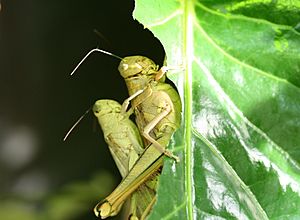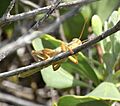Valanga irregularis facts for kids
Quick facts for kids Valanga irregularis |
|
|---|---|
 |
|
| Valanga irregularis | |
| Scientific classification | |
| Kingdom: | |
| Phylum: | |
| Subphylum: | |
| Class: | |
| Order: | |
| Family: | |
| Genus: |
Valanga
|
| Species: |
V. irregularis
|
| Binomial name | |
| Valanga irregularis (Walker, F., 1870)
|
|
The Valanga irregularis is a very large grasshopper often called the "giant grasshopper" or "giant valanga". It belongs to the Acrididae family, which includes many common grasshoppers. You can only find this amazing insect in the warm, tropical and subtropical parts of Australia. It's known for being the biggest grasshopper on the entire continent! Usually, these grasshoppers like to live by themselves.
Contents
About the Giant Grasshopper
Both male and female giant grasshoppers look quite similar, but they are different sizes. Female grasshoppers are bigger, growing up to 60 to 75 millimeters long. Males are a bit smaller, usually between 45 and 55 millimeters. This makes them the largest grasshoppers in Australia. Some people have even reported seeing them as long as 90 millimeters!
Their body color and patterns can change a lot. Adult giant grasshoppers are usually creamy brown to grayish green. Their front wings have cool black dots, and their back wings are dark gray. Sometimes, the back wings can even be clear or light green. If you look closely at their legs, you'll see orange and red spines with black tips on their lower legs.
Where They Live
The Valanga irregularis lives in the tropical and subtropical areas of Australia. This means you can find them north of Sydney, where it's warm and often wet.
These grasshoppers really like places with a lot of moisture. In spring and autumn, you can often spot them in grasslands or forests. If the weather is just right, they might even visit suburban gardens!
What They Eat and Do
The Valanga irregularis loves to munch on shrubs, especially plants like Acalypha, Hibiscus, or Bauhinia. They also enjoy eating palm trees. They have very strong jaws, called mandibles, which they use to start eating a leaf from its edge. These grasshoppers eat all night long. During hot or rainy days, they stay hidden behind branches to keep safe and dry.
Adult giant grasshoppers are excellent jumpers. They can also defend themselves from predators like mantises or lynx spiders using the spines on their back legs. Plus, they are very good at hiding! Their body color helps them blend in perfectly with the plant stems and leaves where they hide. This makes it hard for predators to see them.
Most of the time, Valanga irregularis lives alone and doesn't form big groups or swarms. However, if conditions are really good, they might gather in small groups. When this happens, they can sometimes cause a little damage, for example, to young coffee berries. But don't worry, they are not usually considered a major pest that causes big problems for crops.
During the winter, adult grasshoppers generally stay in their hiding spots. But they don't completely sleep! They will sometimes leave their hiding place to eat or to warm up in the sun. The time for them to find a mate starts when the first warm days of spring arrive. Males make noises to call the females, and they usually meet where there's plenty of food.
Life Cycle of the Giant Grasshopper
Giant grasshoppers have one generation born each year. Their life cycle is perfectly timed with the wet and dry season in the tropics. Females lay their eggs in early summer. Each egg is about 5-6 millimeters long. To lay her eggs, the female digs a cylinder-shaped tunnel up to 90 millimeters deep into the moist soil. She then lays up to 150 eggs at the bottom of this tunnel. After laying the eggs, she plugs the tunnel with a foamy substance. This foam helps keep the eggs moist during the dry season.
The tiny nymphs, which are about 5 millimeters long, hatch and leave the tunnel when the first heavy rain falls. Over the next three months, they grow through seven different stages, called instar stages. In late summer and autumn, they have their final molt to become adult grasshoppers, also known as imagos. The last nymph stage looks very much like an adult but cannot fly yet.
How They Got Their Name
The Valanga irregularis species was first described by a British insect expert named Francis Walker in 1870. The original specimen he used to describe the species is still kept at the Natural History Museum in London.
The name "Valanga" comes from the Javanese word for "grasshopper." The second part of its scientific name, "irregularis," is Latin for "irregular." This part of the name points to how much the color of these grasshoppers can vary.
Images for kids





